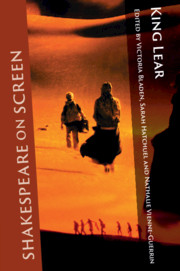Book contents
- Shakespeare on Screen: King Lear
- Series page
- Shakespeare on Screen: King Lear
- Copyright page
- Dedication
- Contents
- Illustrations
- Notes on Contributors
- Series Editors’ Preface
- Acknowledgements
- Chapter 1 Introduction: Dis-locating King Lear on Screen
- Part I Surviving Lear: Revisiting the Canon
- Chapter 2 Lear’s Fool on Film: Peter Brook, Grigori Kozintsev, Akira Kurosawa
- Chapter 3 Wicked Humans and Weeping Buddhas: (Post)humanism and Hell in Kurosawa’s Ran
- Part II Lear en Abyme: Metatheatre and the Screen
- Part III The Genres of Lear
- Part IV Lear on the Loose: Migrations and Appropriations of Lear
- Index
- References
Chapter 3 - Wicked Humans and Weeping Buddhas: (Post)humanism and Hell in Kurosawa’s Ran
from Part I - Surviving Lear: Revisiting the Canon
Published online by Cambridge University Press: 10 September 2019
- Shakespeare on Screen: King Lear
- Series page
- Shakespeare on Screen: King Lear
- Copyright page
- Dedication
- Contents
- Illustrations
- Notes on Contributors
- Series Editors’ Preface
- Acknowledgements
- Chapter 1 Introduction: Dis-locating King Lear on Screen
- Part I Surviving Lear: Revisiting the Canon
- Chapter 2 Lear’s Fool on Film: Peter Brook, Grigori Kozintsev, Akira Kurosawa
- Chapter 3 Wicked Humans and Weeping Buddhas: (Post)humanism and Hell in Kurosawa’s Ran
- Part II Lear en Abyme: Metatheatre and the Screen
- Part III The Genres of Lear
- Part IV Lear on the Loose: Migrations and Appropriations of Lear
- Index
- References
Summary
Akira Kurosawa spent fifty years, from 1943 to 1993, making films that attempt to look at life and its complexity ‘straight on’, in an unflinching, uncompromising way. However, none of his films forces us to stare into the potential for humans to create hell on earth quite as formidably as one of his final masterpieces, Ran (1985). This chapterfocuseson Kurosawa’s troubled humanism, alongside his didacticism. It is no accident that three such Kurosawa films are his adaptations of Shakespeare tragedies: Throne of Blood, The Bad Sleep Well (1960) and Ran, adaptations of Macbeth, Hamlet and King Lear, respectively. Kurosawa uses Ran to express his belief in the compelling need for individuals to transcend the unending cycles of violence that plague this world, rather than embrace the dubious otherworldly salvation provided by supernatural powers, such as Amida Buddha, who appears as a helpless symbol in Ran. The film is a majestic pageant full of symbols and abstractions – including many elements of the Buddhist Noh theatre – which ironically signify unity and harmony in a collapsing world where icons have lost their power to cohere. Ran, in all its beauty and horror, tells us that we have the power to face the inevitable hells on earth and choose not to perpetuate them.
- Type
- Chapter
- Information
- Shakespeare on Screen: King Lear , pp. 47 - 62Publisher: Cambridge University PressPrint publication year: 2019
References
Works Cited
- 1
- Cited by

